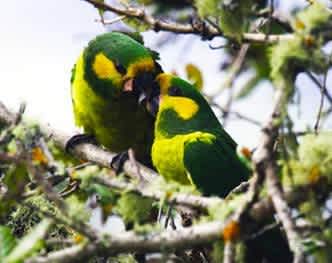Birds in Trouble Globally, but Cooperative Conservation Approach Getting Results
OutdoorHub 07.09.12

The recent announcement by the International Union for the Conservation of Nature (IUCN) that the number of globally at-risk bird species on their “Red List” has risen from 1,253 last year to 1,331 this year is cause for concern, but a cooperative approach to bird conservation being implemented by American Bird Conservancy (ABC) and its partners is achieving positive results in Central and South America, and providing a roadmap for real change.
The ABC approach employs two key principals: partnership with in-country conservation groups and a focus on protecting key sites and bird species in most peril.
The results are measureable and significant. Since 1999, ABC has partnered with 20 organizations in ten countries to create a network of 44 bird reserves, most of whom are part of a new, Latin American Bird Reserve Network. The reserves protect over 40 percent of the rarest bird species in the Americas—39 out of 96 species that are found only at one last location on Earth. Additionally, ABC and partners have expanded conservation efforts to include imperiled species that inhabit only a few remaining sites, and already, 16 percent (30 of 189 species) are receiving protection.
Several examples of the successful model promoted by ABC and partners are a suite of species that have seen their threat status reduced in recent years. ABC has partnered with Fundación ProAves in Colombia on the Yellow-eared Parrot, Fundação Biodiversitas in Brazil on the Lear’s Macaw, and Fundación Jocotoco in Ecuador on the Pale-headed Brush-finch. All three bird species have experienced population growth due to conservation of their habitat through private reserves. Each has had their threat status reduced from Critically Endangered to Endangered by the IUCN.
The ABC partner reserves are established through donations to ABC, other international conservation organizations, local partners, and through local government initiatives. Management of the reserves typically rests with either the local organization or a partnership between the local organization and local communities or governments.
The reserves are especially attractive to tourists, not only for the spectacular rare birds and other wildlife that can be seen, but also because funds raised through tourism go directly to the local organization to support conservation of those species and their habitats.
“International birding travel is already popular, and we want more birders to know that their pastime can actually contribute to saving the species they love,” said Mike Parr, Vice President for Program Development at ABC. “Visiting birders can provide a source of direct income to the reserves, helping them become self-sufficient and sustainable in the long term.”
ABC has called this effort Conservation Birding, and created an interactive website, www.conservationbirding.org that has been designed specifically to help visitors plan birding trips to help conservation. The site presents detailed information on the reserves and ecolodges established by the conservation groups. A Google Earth component adds another dimension by presenting suggested routes, photographs of lodges and birds, and videos of rare and interesting species.
To further global endangered species conservation, ABC also helped found the Alliance for Zero Extinction, a joint international initiative of 80 biodiversity conservation organizations that aims to prevent species extinctions by identifying and safeguarding key sites, each of which is the last remaining refuge for one or more Endangered or Critically Endangered species. AZE’s goal is to create a frontline of defense against extinction by protecting as many of these sites as possible.
“Because time is running out for many species, this effort begins with the crises we know about, and expands its focus as new information emerges on the status of species and their habitats,” said Parr, who is also Chair of AZE.
To date, AZE has identified 587 sites worldwide that are the last refuges for 920 of the world’s most highly threatened species; 200 of these are bird species, with 96 of those in Latin America and the Caribbean. Examples include the Blue-billed Curassow, Royal Cinclodes, Marvelous Spatuletail, and Santa Marta Parakeet in Latin America, and the Whooping Crane and a number of Hawaiian bird species such as the Palila and Maui Parrotbill in the United States. The Latin American Bird Reserve Network reflects the implementation by ABC and its partners of AZE principles to save these species.

